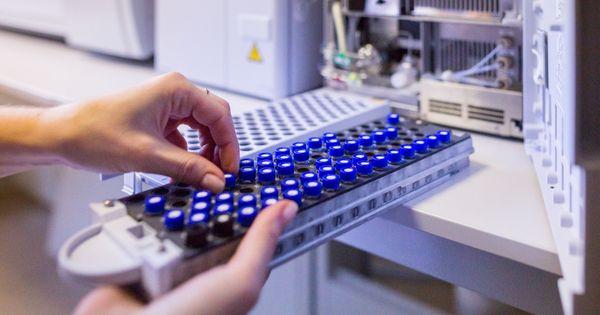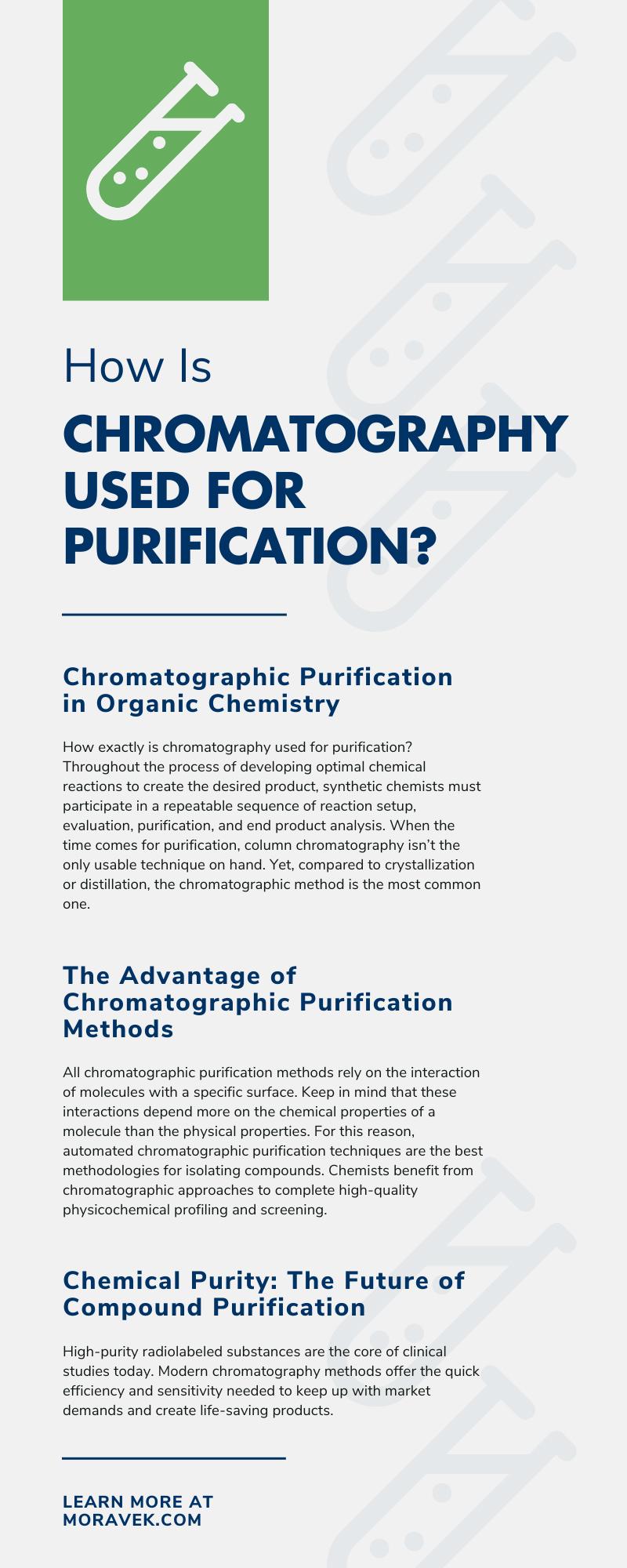
Nothing is more significant for meeting regulatory compliance in clinical research than chemical analysis. The ability to identify and understand the composition of chemical substances used in products or manufacturing processes ensures the highest quality standards.
Applying industry expertise and specialist knowledge to the most relevant methodologies is essential for success. It’s how we advanced analytical equipment and an amalgamation of proven scientific techniques, such as chromatography. Chromatography is a laboratory technique that identifies, separates, and analyzes different chemical compounds based on their properties. With the use of high-precision instrumentation, the resulting differential distribution reveals chemical identification and the presence of any compound impurities.
How is the science of chromatography used for purification? Let’s take a closer look at chromatography as a whole—and its specific technical applications for achieving optimal chemical purity levels. Here’s what to know about this notable method of chemicalseparation and purification.
The History of Chromatography
Over time, scientific advancements have emerged in society due to consistent improvements in existing technologies and conceptual knowledge. The initial invention of chromatography—the separation of targeted substances in a laboratory—traces back to the late 19th to the early 20th century.
Mikhail Tsvet completed the rudimentary chromatography principles from previous researchers. The botanist studied and separated a complex solution of organic plant pigments through a column by a series of colors. As the years went by, an increasing multitude of chemists found column chromatography to be an exceptional technique for studying and isolating various forms of complex mixtures.
A Technical Art and Science: Modern Laboratory Work
Utilized first by artists and color theorists to create industrial dyes and patterns in textile fabrics, chromatography has come a long way to become what it is today. Color does not play a main role in the chromatographic process anymore and instead has brought a unique branch of analytical chemistry that separates chemical compounds by characteristic properties.
Chromatographic methods are valuable laboratory technology tools for compound separation, identification, and purification. The same principles still apply in present-day laboratories for any type of chemical analysis process. Modern chemists use widely available methodologies and instruments to understand and purify liquid mixtures for beneficial industry applications.
The Different Types of Chromatography
Regardless of the chosen chromatographic method, scientists can compare isolated compounds from a mixed sample to known standards for proper quality assurance and purification. Properly analyzing a sample's chemical composition requires the right techniques for determining chemical quality, identity, and the impurities.
Chemists use four primary types of chromatography today: gas chromatography, paper chromatography, thin-layer chromatography, and high-performance liquid chromatography. Each efficient method has its own advantages in diverse industries, from forensic science to critical clinical research. The right choice for chemical analysis and purification depends on the specified industry and scenario. Small versus. large experiments or non-volatile versus volatile compound mixtures demand the application of different methods.
How Chromatography Works: Basic Applications
Although the previously mentioned chromatography techniques differ by approach, each type depends on molecular variations and material mobility. Generally, all forms of chromatography have two phases. Each works by dissolving a mixture sample in a primary mobile phase, then transporting the targeted compounds through a stationary phase. In this secondary step, computer-controlled equipment isolates components based on their speed of travel.
The process of chromatography works by running the dissolved material through a filter. When passing through the filter, the molecules in the compound separate into layers. Remember, the machine or instrument used for separation depends on the chosen filtering method, determined by the chemical components needing to be isolated for analysis.
An Analytical vs. Purification Tool
In the context of chemical compound separation, chromatography has two standard applications: either an analytical or a purification tool. For analysis purposes, a chromatographic method reads and records the exact contents of the sample. Conversely, for purification purposes, chromatography techniques work to safely separate and use the components of the mixture in experiments or procedures.
Analytical chromatography customarily requires less material than chromatography meant to purify compound materials. Either way, chromatography has a tremendous advantage for lower concentrations of materials or smaller samples for medical or pharmaceutical testing.
Chromatographic Purification in Organic Chemistry
How exactly is chromatography used for purification? Throughout the process of developing optimal chemical reactions to create the desired product, synthetic chemists must participate in a repeatable sequence of reaction setup, evaluation, purification, and end product analysis. When the time comes for purification, column chromatography isn’t the only usable technique on hand. Yet, compared to crystallization or distillation, the chromatographic method is the most common one.
How come? The first undertaking for compound identification is to obtain that material in its purest form. The best approach for achieving this objective is through seamless chromatography in a laboratory. With the right skill sets and analytical instruments, chemists can reach the required level of purity in the least number of steps.
The Advantage of Chromatographic Purification Methods
All chromatographic purification methods rely on the interaction of molecules with a specific surface. Keep in mind that these interactions depend more on the chemical properties of a molecule than the physical properties. For this reason, automated chromatographic purification techniques are the best methodologies for isolating compounds. Chemists benefit from chromatographic approaches to complete high-quality physicochemical profiling and screening.
Suppose you aim to study or evaluate complex compound mixtures in pharmaceutical production. You should know that different purification chromatography techniques support the enrichment of these target products, enhance their stability, remove certain impurities from APIs that could impact safety and efficiency, minimizes raw material waste, and prevents overall product degradation.
Chemical Purity: The Future of Compound Purification
The latest scientific and technological advancements have shaped the significance of modern-day chromatography. Used for purification purposes by experts in laboratories around the globe, these innovative techniques have helped develop a variety of drugs, therapies, and treatments for medical patients.
High-purity radiolabeled substances are the core of clinical studies today. Modern chromatography methods offer the quick efficiency and sensitivity needed to keep up with market demands and create life-saving products. As the most recent era of purification for novel compounds grows, contract purification services will continue to drive a variety of products with safe ingredients to the market.
High-Performance Liquid Chromatography Purification Services
Moravek is a contract supplier organization for custom radiolabeled compounds. If you need an isotope labeling service for a complex project, our skilled team can handle the process smoothly and efficiently to meet your research goals.
Moravek’s in-house radiochemical purification services include the use of HPLC, flash, and gas chromatography techniques for specialized medical research studies. Contact us to learn more about our high-quality synthesis, purification, and analytical services with state-of-the-art laboratory facility and equipment.

